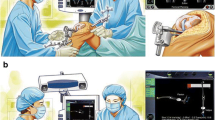Abstract
Soft tissue balancing in total knee replacement (TKR) is paramount to obtain optimal stability of the joint, improve kinematics, produce equal load on each side of the prosthetic components and decrease component wear [1]. Whilst the role of computer navigation is well established as the most accurate means of obtaining desired coronal and sagittal alignment, its role in soft tissue balancing is more recent. The use of navigation data allows the surgeon to recognise imbalance including midflexion instability, excessive tightness in flexion, failure to resolve flexion contractures and persisting pathological recurvatum. Navigation derived information allows the surgeon a real time assessment of stability throughout the flexion arc and importantly these objective measurements enable the surgeon to address the abnormalities and confirm resolution before the patient leaves the operating room
Access this chapter
Tax calculation will be finalised at checkout
Purchases are for personal use only
Similar content being viewed by others
References
Seon JK et al. In vivo stability of total knee arthroplasty using a navigation system. Int Orthop. 2007;31(1):45–8.
Sharkey PF et al. Insall award paper. Why are total knee arthroplasties failing today? Clin Orthop Relat Res. 2002;404:7–13.
Roche M, Elson L, Anderson C. Dynamic soft tissue balancing in total knee arthroplasty. Orthop Clin North Am. 2014;45(2):157–65.
Kurtz SM et al. Future young patient demand for primary and revision joint replacement: national projections from 2010 to 2030. Clin Orthop Relat Res. 2009;467(10):2606–12.
Blakeney WG, Khan RJ, Wall SJ. Computer-assisted techniques versus conventional guides for component alignment in total knee arthroplasty: a randomized controlled trial. J Bone Joint Surg Am. 2011;93(15):1377–84.
Matziolis G et al. A prospective, randomized study of computer-assisted and conventional total knee arthroplasty. Three-dimensional evaluation of implant alignment and rotation. J Bone Joint Surg Am. 2007;89(2):236–43.
Decking R et al. Leg axis after computer-navigated total knee arthroplasty: a prospective randomized trial comparing computer-navigated and manual implantation. J Arthroplasty. 2005;20(3):282–8.
Hetaimish BM et al. Meta-analysis of navigation vs conventional total knee arthroplasty. J Arthroplasty. 2012;27(6):1177–82.
Jeffery RS, Morris RW, Denham RA. Coronal alignment after total knee replacement. J Bone Joint Surg Br. 1991;73(5):709–14.
Choong PF, Dowsey MM, Stoney JD. Does accurate anatomical alignment result in better function and quality of life? Comparing conventional and computer-assisted total knee arthroplasty. J Arthroplasty. 2009;24(4):560–9.
de Steiger RN, Liu YL, Graves SE. Computer navigation for total knee arthroplasty reduces revision rate for patients less than sixty-five years of age. J Bone Joint Surg Am. 2015;97(8):635–42.
Griffin FM, Insall JN, Scuderi GR. Accuracy of soft tissue balancing in total knee arthroplasty. J Arthroplasty. 2000;15(8):970–3.
Dennis DA et al. Gap balancing versus measured resection technique for total knee arthroplasty. Clin Orthop Relat Res. 2010;468(1):102–7.
Arima J et al. Femoral rotational alignment, based on the anteroposterior axis, in total knee arthroplasty in a valgus knee. A technical note. J Bone Joint Surg Am. 1995;77(9):1331–4.
Berger RA et al. Determining the rotational alignment of the femoral component in total knee arthroplasty using the epicondylar axis. Clin Orthop Relat Res. 1993;286:40–7.
Olcott CW, Scott RD. A comparison of 4 intraoperative methods to determine femoral component rotation during total knee arthroplasty. J Arthroplasty. 2000;15(1):22–6.
Jerosch J et al. Interindividual reproducibility in perioperative rotational alignment of femoral components in knee prosthetic surgery using the transepicondylar axis. Knee Surg Sports Traumatol Arthrosc. 2002;10(3):194–7.
Poilvache PL et al. Rotational landmarks and sizing of the distal femur in total knee arthroplasty. Clin Orthop Relat Res. 1996;331:35–46.
Griffin FM, Insall JN, Scuderi GR. The posterior condylar angle in osteoarthritic knees. J Arthroplasty. 1998;13(7):812–5.
Parker DA et al. Safety of combined use of local anesthetic infiltration and reinfusion drains in total knee arthroplasty. J Arthroplasty. 2009;24(6):918–24.
Widmer B et al. Incidence and severity of complications due to femoral nerve blocks performed for knee surgery. Knee. 2013;20(3):181–5.
Widmer BJ et al. Is femoral nerve block necessary during total knee arthroplasty?: a randomized controlled trial. J Arthroplasty. 2012;27(10):1800–5.
Smith TO, Hing CB. Is a tourniquet beneficial in total knee replacement surgery? A meta-analysis and systematic review. Knee. 2010;17(2):141–7.
Lustig S et al. Sagittal placement of the femoral component in total knee arthroplasty predicts knee flexion contracture at one-year follow-up. Int Orthop. 2012;36(9):1835–9.
Whiteside LA. Soft tissue balancing: the knee. J Arthroplasty. 2002;17(4 Suppl 1):23–7.
Nodzo SR, Franceschini V, Gonzalez Della Valle A. Intraoperative load-sensing variability during cemented, posterior-stabilized total knee arthroplasty. J Arthroplasty. 2017;32(1):66–70.
Saragaglia D, Chaussard C, Rubens-Duval B. Navigation as a predictor of soft tissue release during 90 cases of computer-assisted total knee arthroplasty. Orthopedics. 2006;29(10 Suppl):S137–8.
Engh GA. The difficult knee: severe varus and valgus. Clin Orthop Relat Res. 2003;416:58–63.
Matsumoto T et al. Soft tissue balance measurement in posterior-stabilized total knee arthroplasty with a navigation system. J Arthroplasty. 2009;24(3):358–64.
Joseph J et al. The use of navigation to achieve soft tissue balance in total knee arthroplasty - a randomised clinical study. Knee. 2013;20(6):401–6.
Song EK et al. Comparative study of stability after total knee arthroplasties between navigation system and conventional techniques. J Arthroplasty. 2007;22(8):1107–11.
Pang HN et al. Computer-assisted gap balancing technique improves outcome in total knee arthroplasty, compared with conventional measured resection technique. Knee Surg Sports Traumatol Arthrosc. 2011;19(9):1496–503.
Author information
Authors and Affiliations
Corresponding author
Editor information
Editors and Affiliations
Rights and permissions
Copyright information
© 2017 ISAKOS
About this chapter
Cite this chapter
Regazzola, G.V.M., Coolican, M.R.J. (2017). Intraoperative Assessment with Computer Navigation. In: Matsuda, S., Lustig, S., van der Merwe, W. (eds) Soft Tissue Balancing in Total Knee Arthroplasty. Springer, Berlin, Heidelberg. https://doi.org/10.1007/978-3-662-54082-4_14
Download citation
DOI: https://doi.org/10.1007/978-3-662-54082-4_14
Published:
Publisher Name: Springer, Berlin, Heidelberg
Print ISBN: 978-3-662-54081-7
Online ISBN: 978-3-662-54082-4
eBook Packages: MedicineMedicine (R0)




